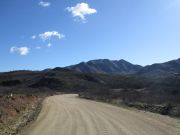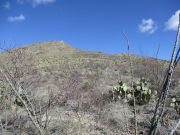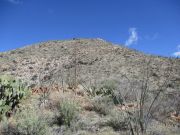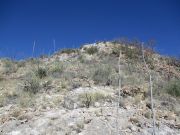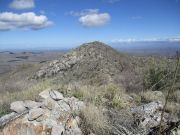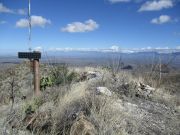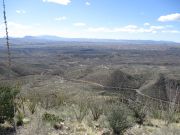
The Mountains of Arizona
• www.surgent.net
|
| Empire Mountains HP |
• Highpoint: Empire Mountains • Arizona State Trust Land • Pima County |
|
Date: March 17, 2024
• Elevation: 5,587 feet (Lidar)
• Prominence: 997 feet (Lidar)
• Distance: 1.9 miles
• Time: 1 hour, 45 minutes
• Gain: 958 feet (gross)
• Conditions: Cool, clear, calm
Arizona
•
Main
•
PB
•
LoJ
The Empire Mountains lie northeast of the Santa Rita Mountains in eastern Pima County, about 35 miles southeast of Tucson and 15 miles north of Sonoita. State route AZ-83 runs west of the range as is the de-facto boundary of the range, separating it from the Santa Ritas. For reference, Mount Fagan is the biggest nearby peak, about five miles due west.
The Empire Ranch was once one of Arizona's biggest cattle ranches, being founded about 1870 and privately-owned for nearly a century, until 1969, when it was purchased by a corporation intending to turn the whole region into homes and development, but that never happened. In 1988, the Bureau of Land Manegement assumed control, but still preserves the ranch and its buildings, and it still functions as a ranch under a leasee. The public can visit the original buildings and there are many programs aimed for the public to enjoy.
The Empire Mountains lie north of the main bulk of the Empire Ranch, but according to the BLM website, the summit and some of the surrounding peaks lie within the historic boundaries of the ranch. Otherwise, land-use maps show the area around the main peak as being contiguous State Trust land.
I finally got a fire lit under my butt to go hike the range's highpoint, which has no name and just goes by Empire Mountains Highpoint. It is a short hike, less than two miles round trip, but going by previous trip reports, very steep and brushy. I would find out for myself.
I left Bsibee a little after 7 a.m., the day completely clear and calm after a couple days of clouds, rain and strong wind. I stopped in Sierra Vista for gas and snacks, then took the highways to Sonoita, and north on AZ-83 to the turn-off onto Hilton Ranch Road just north of milepost 49.
The area is State Trust, but also dotted with small homesteads. The main road is dirt hardpack. A sign at the start mentioned that the road is maintained by the property owners, but I saw no signs explicitly forbidding access. Mindful of this, I went very slow so as not to kick up dust and otherwise attract attention to myself.
As the road gains toward a pass south of the highpoint, it steepens and is asphalted for the last mile. It is a narrow road with no room to pull aside for oncoming cars. I went slow and hoped no one was coming the other way. At the pass, I parked off the asphalt, put my State Lands permit in my window, and got myself prepared for the short hike. I had covered about 80 miles from Bisbee.
I started walking at 8:55 a.m.. The conditions were mild, temperature about 55°. There is no mystery to the route. Above me was a false summit, and beyond it was the highpoint, invisible for now. The false summit rose about 700 feet higher. From below, the slopes looked steep but nothing I haven't seen before.
I entered into the thorny brush and did my best to avoid the thorn brush, ocotillo stalks and cactus spines. It was thick at the start but lessened as I gained elevation. The route follows a ridge hemmed in by two drainages. It angles north at first, then a soft bend left, to gain the highpoint of this lower ridge, a gain of about 350 feet. Getting here was easy. Aside from the thorns and spines, I also had to contend with rolling rocks. But overall, this segment was very straightforward.
As I was still low on the slopes, I heard a vehicle engine and looked down. A pick-up truck was slowly coming up this road. He slowed as he got to my car, then just drove on past. About fifteen minutes later, as I was near the lower ridge highpoint, he came back. He slowed as he passed my car then stopped. So I watched, as I had no other option. I was relieved when he just got moving and left my car alone.
Looking up, there is a noticeable white-colored rock outcrop seemingly at the false summit. The idea is to angle right and catch the ridge more to the southeast, then follow that up toward the white rocks. As I was traversing over, I tended to go up too, so that I decided to just bust upslope from where I was. This worked but was sloppy. I had to scramble up a couple broken cliffs, then on the white rocks, pick my way up some open faces. Footing was very good, but the runout could be lengthy. I was soon past these white rocks and in moments, on the false summit.
From the false summit, I could see the highpoint about a quarter-mile north. The highpoint rises about ten feet higher than the false summit. Between the two summits is about a 110-foot drop, and a rocky ridge that leads to the top. From where I stood, it looked rocky and potentially rough.
I slowly started to descend off the false summit. This was steep, mostly easing down limestone rocks and sloppy rock piles, as well as dense brush. I just went slow and occasionally got on all fives to get down some of the rocks. I then got onto the rocky spine of the ridge and stayed high. It was narrow but never treacherous. As I neared the highpoint hill, I could see it lay back and also sense ways up through its rocks and brush.
The last hundred vertical feet went well, there being what I sensed was a path. I arrived on top, tagging the highest rock near the summit cairn. A solar-powered antenna stands a few feet to the side. I signed into the register. This peak sees a steady stream of people but never more than a handful a year. Someone was here a month ago.
Views were good. Some clouds had started to collect on the highest peaks, especially over by Mount Wrightson. Above me it was still clear, just a random puffy cloud here and there. It was cool but calm, no breeze to chill me. It took me exactly one hour to get here, and I spent about five minutes relaxing and looking around.
I was eager to get back down, to get through the rocks and brush while I remembered what to do, and to get back to my car quickly. I had no trouble getting back to the false summit. Going down, I found a nice slope that bypassed the white rocks, and what I should have taken going up. I stayed more on the southeastern ridge, and other than use my hands once or twice to ease down a rock jumble, managed to do this entirely upright.
Below the steepest slopes, I made better time going down the last 450 feet, and I was back to my car at 10:40 a.m., a 40-minute descent. I was especially pleased to be done. This is a range highpoint and barely misses out on being a 1000-foot prominence peak (997 feet going by Lidar). I was not expecting any issues, but I was glad to be back at my car. I did not waste any time. I got in and drove out to the highway.
Empire Mountain was a short and aggressive peak, but not unduly difficult. I made it harder for myself by attacking the white rocks directly. My suggestion is to stay left going up. The remaining scrambling was never beyond Class-2, but it was often messy with abundant brush and/or loose rocks. This is the kind of terrain that forces one to move slowly. Still, one hour up and 40 minutes down was a fast time for an old man like me.
I did not feel completely comfortable parking my car where I did, in that I don't know how locals feel with people being on their roads. I would recommend to future visitors to be courteous and tidy, to go slow, and not mistreat this access allowance.
|
|
